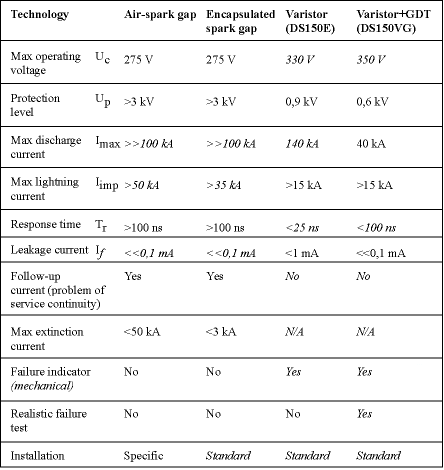
The solutions employed to protect low voltage networks against transient overvoltages induced by lightning strikes - surge protection devices (SPDs) - are now widely spread. However, the choice between the different technologies available on the market is not that easy. Various solutions are available, especially in the 'high energy' SPD segment, for products used in sites with a lightning protection system - according to the Class I test of the international standard IEC61643-11) - or used in sites under extreme stress.
SPD technologies
The main technologies used in low voltage SPDs are described below:
* Air spark gap. Device generally made of two electrodes facing each other (V shape). The spark appears between the electrodes (+ the follow-up current) when an overvoltage reaches a certain value. On power networks, in order to stop the follow-up current, the principle of 'arc quenching' is used, the final consequence being the expulsion of the hot gas: this behaviour requires a special installation.
* Encapsulated spark gap: Air spark gap where the extinction of the follow-up current is achieved without expulsion of gas: this usually reduces the capacity to switch off the follow-up current.
* Gas discharge tube: Device made of an hermetic envelope, filled up with rare gas under a controlled pressure. This component is usually used and is well adapted to the protection of telecom networks. Its main feature is its very low follow-up current extinction capability and its much better stability than the air spark gap.
* Varistor: Nonlinear component (the resistance varies according to the voltage) made of zinc oxide (ZnO) that allows a limitation of the voltage. The clamping nature of operation enables avoidance of follow-up current which turns the varistor into a component very well adapted to the protection of the power networks.
* Varistor with thermal disconnection: Varistor equipped with an auxiliary device to disconnect the component in case of overheating: this behaviour is indispensable to guarantee a controlled end of the life of the varistors connected to the power network and to comply with the standard. In order to increase the discharge current, an efficient solution is to put in parallel a selection of varistors (Citel DS150E).
* GDT+varistor: Association of components in series to take advantage of both technologies: no leakage current and very low Up (maximum residual voltage) - gas discharge tube section and no follow-up current (varistor). To reach high amplitude of impulse current, technologies of association of specific gas discharge tubes (Citel DS150VG) will be needed.

Final analysis
It clearly appears that the technologies based on varistors (DS150E) and varistors+gas discharge tubes (DS150VGT) are the best compromise, with the exception of what concerns the discharge capacities in wave 10/350 µs. However, the estimation of real risk, as well as feedback from the field, shows that values of 15 kA in wave 10/350 are high enough.
For further information contact Citel representative in South Africa, Epsilon, (011) 622 5055.

© Technews Publishing (Pty) Ltd | All Rights Reserved